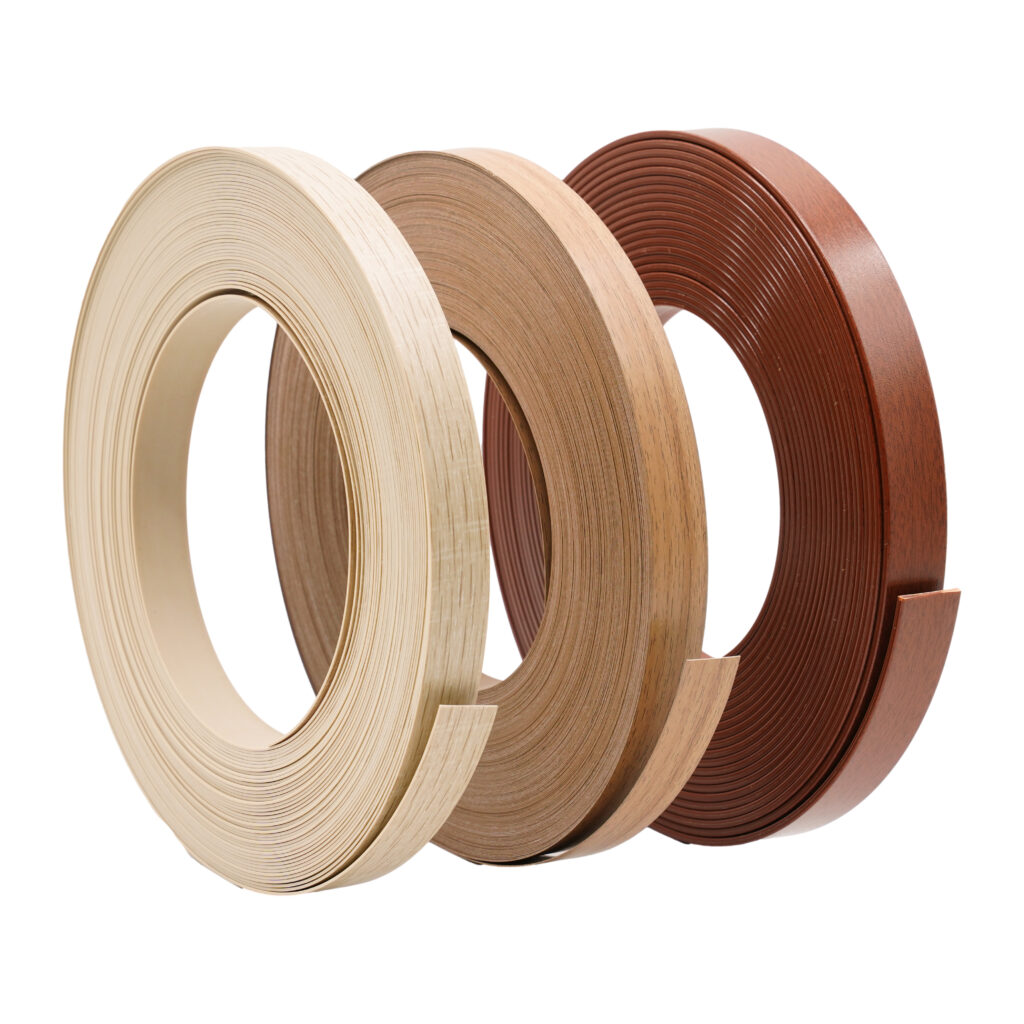Edge Banding – A Complete Guide for Furniture Manufacturers & Distributors
Share on

Edge Banding – A Complete Guide for Furniture Manufacturers & Distributors
In the world of modern furniture manufacturing, every millimeter counts. Edge banding, though often seen as a small detail, is one of the most essential components determining a furniture’s durability, aesthetics, and overall quality perception. For professional manufacturers and distributors, understanding how to select and apply the right edge banding is key to maintaining consistent production standards and long-term client trust.
1. What Is Edge Banding? Definition and Function in Furniture Production
Edge banding refers to the thin material—usually made of PVC, ABS, melamine, wood veneer, or acrylic—used to cover and seal the exposed edges of furniture panels, such as MDF, particleboard, or plywood.
Its primary functions are:
-
Protection: Prevents moisture penetration, surface chipping, and impact damage.
-
Aesthetic enhancement: Provides a seamless, finished look matching the panel’s color and texture.
-
Durability: Extends furniture lifespan by reinforcing edges against daily wear.
-
Hygiene and safety: Eliminates sharp edges and makes surfaces easier to clean.
In furniture production, edge banding serves both structural and decorative purposes. While the inner core gives strength to the furniture, it’s the edge banding that defines its appearance, feel, and precision. For example, in high-end kitchen furniture, even a 0.2 mm misalignment can disrupt the entire visual harmony of the cabinet door.
In other words, edge banding is where craftsmanship meets industrial precision.
2. Main Applications of Edge Banding in Modern Furniture Manufacturing
Edge banding is indispensable across multiple furniture categories. Below are its most common applications:
a. Kitchen and Bathroom Cabinets
Edge banding protects against humidity and frequent cleaning chemicals. PUR hot melt adhesive is often used in these applications because of its strong water resistance and temperature stability.
b. Office Furniture Systems
In work desks, drawers, and modular partitions, edge banding ensures professional finishing and long-term durability. The use of 1mm ABS edge banding is common here, providing a balance between flexibility and toughness.
c. Wardrobes and Closets
For sliding doors or vertical panels, 0.45mm and 0.8mm PVC edge banding are favored for lightweight precision. White, gray, and woodgrain colors dominate this segment, reflecting minimalistic design trends.
d. Retail and Commercial Fixtures
Edge banding in retail displays adds visual consistency and helps brands maintain a unified aesthetic across store locations.
e. Educational and Institutional Furniture
Tables, storage units, and laboratory panels benefit from thicker 2mm PVC edge banding, which resists constant impact and cleaning.
In our factory’s experience, over 60% of our clients use PVC edge banding in 0.45–2mm thickness for melamine boards, confirming its dominance in today’s furniture manufacturing lines.
3. Common Edge Banding Materials and Their Technical Characteristics
Choosing the right material is one of the most decisive factors in achieving the desired appearance and performance. Below is a comparative overview based on practical factory data and over 10 years of manufacturing experience.
| Material | Advantages | Limitations | Typical Use |
|---|---|---|---|
| PVC (Polyvinyl Chloride) | Cost-effective, flexible, easy to process, wide color range | Moderate heat resistance | General furniture, melamine boards |
| ABS (Acrylonitrile Butadiene Styrene) | Eco-friendly (no chlorine), higher impact strength, recyclable | Slightly higher cost | Office furniture, green projects |
| Melamine | Matches perfectly with melamine boards, economical | Less flexible, limited durability | Low-cost furniture, shelves |
| Wood Veneer | Natural look and texture | Sensitive to moisture | Premium furniture, cabinetry |
| Acrylic (PMMA) | Glossy 3D finish, UV-resistant | More expensive, requires precision | Luxury furniture, modern décor |
At Angmi, our PVC and ABS edge banding undergo UV surface coating and color calibration under ΔE≤0.5, ensuring consistency across large production batches.
Additionally, we conduct heat deformation tests (≥80°C) and adhesion tests (≥3N/15mm) to guarantee optimal compatibility with both EVA and PUR hot melt adhesives.
4. How to Choose the Right Edge Banding for Your Project
Selecting the correct edge banding involves more than choosing a color. Below are the critical factors every purchasing manager should consider:
a. Thickness and Width
-
0.4–0.6mm: Ideal for lightweight or low-cost furniture.
-
0.8–1mm: Standard choice for most melamine furniture (balance of flexibility and strength).
-
2mm: For heavy-duty applications like schools or commercial use.
b. Color Matching and Texture
Professional suppliers use spectrophotometers and 3D texture scanning to reproduce exact color tones of panels (e.g., Egger, Arauco, Masisa, etc.). A deviation beyond ΔE 1.0 is often visible to the human eye.
c. Adhesive Compatibility
If your factory uses PUR glue, ensure the edge banding has high thermal stability and surface energy compatible with moisture-curing adhesives.
For EVA glue, select products that melt and adhere efficiently at 180–200°C.
d. Environmental and Safety Certifications
More buyers—especially in Latin America and Europe—demand RoHS, REACH, and VOC-free compliance.
Our own testing data show that low-VOC PVC edge banding improves air quality in furniture production workshops by up to 25%.
e. Packaging and Logistics
Even the best edge banding loses its quality if poorly packed. Rolls should be sealed with moisture-proof film, stored horizontally, and protected from sunlight.
A reliable supplier provides clear labeling (color code, batch, lot number), allowing you to maintain traceability and inventory efficiency.
5. Global Market Trends and Innovations in Edge Banding Industry
The edge banding market is evolving rapidly, driven by technological innovation and sustainability trends. Based on our international export data to Peru, Chile, Mexico, and the U.S., we observe the following patterns:
a. Eco-Friendly Materials
ABS and recycled PVC are gaining popularity. Factories are investing in solvent-free extrusion and lead-free formulations, meeting stricter global environmental standards.
b. PUR Adhesive Integration
The combination of PUR hot melt glue and high-performance edge banding ensures waterproof and heat-resistant edges—ideal for tropical climates like Latin America.
c. UV and Digital Printing Technology
UV coating enhances surface gloss and scratch resistance, while digital printing enables perfect reproduction of woodgrain and marble designs with minimal color variation.
d. Customization and Short Lead Times
Modern furniture makers now request small MOQ custom colors. Our facility supports color matching within 7 working days, backed by automated colorimetric systems.
e. Sustainability and Circular Economy
Global furniture brands are transitioning toward recyclable edge banding materials. In response, Angmi has developed eco-ABS products that can be reused in production with minimal degradation.
- Tags
Share on

McArthur
As a senior manager at a leading edge banding factory, I’ve witnessed how a millimeter of precision can define a product’s success. Our mission is simple: to help every furniture manufacturer achieve durable, beautiful, and consistent results—edge after edge.

